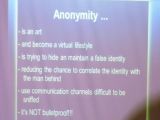Most people tend to associate online anonymity with things such as cybercriminal activities or software piracy, but there is much more to it than that. Online anonymity is highly useful even for regular users, since in many cases the use of a false identity can help us protect ourselves against malicious operations.
This weekend, at the first regional edition of DefCamp, held in Iasi, Romania, Andrei Avadanei, the event organizer, gave a speech called Virtual Anonimity – What? Why? When? How? – in which he highlighted some of the most common techniques that can be utilized to keep our identity private, while performing sensitive task or maybe even while trying to demonstrate a proof of concept.
First of all, depending on how paranoid you are and depending on how secure your identity must remain, there are different degrees of anonymity.
The first wave, which requires few things that are easy to implement, is mainly represented by the use of a public or a private proxy, the use of prepaid cards and maybe an Internet connection that’s acquired from a public Wi-Fi network.
Applications such as TOR, tunneling software and SSL-secured connections are recommended, and when it comes to chat, encryption plug-ins for instant messaging apps can keep a conversation really private.
For those who need something more, a MAC-changer and the use of an operating system such as Linux increase the level of protection as to an Internet user’s anonymity.
A mistake that many people make while surfing the web is that they rely on components such as Java or Adobe, which contain many holes that can easily be exploited to uncover an identity.
Finally, for those who do more dangerous stuff (there are other dangerous things that can be done online besides hacking), the use of a fresh identity is recommended, which must be immediately abandoned as soon as the task is done.
Fake operating systems, software such as TrueCrypt, an encrypted virtual machine, a properly configured firewall, the acquisition of a Wi-Fi connection from a greater distance using devices such as NanoStation M, and tunneling remote desktop through SSH are recommended for those who need extra protection or for those who really know the meaning of the word paranoia.
Before installing all this stuff for a malevolent purpose, keep in mind that not even the most advanced hiding techniques are bulletproof. The more of these mechanisms you utilize, the harder it will be for someone to identify you, but it will never be impossible, especially since at one point you’re bound to mess up.

 14 DAY TRIAL //
14 DAY TRIAL // 
